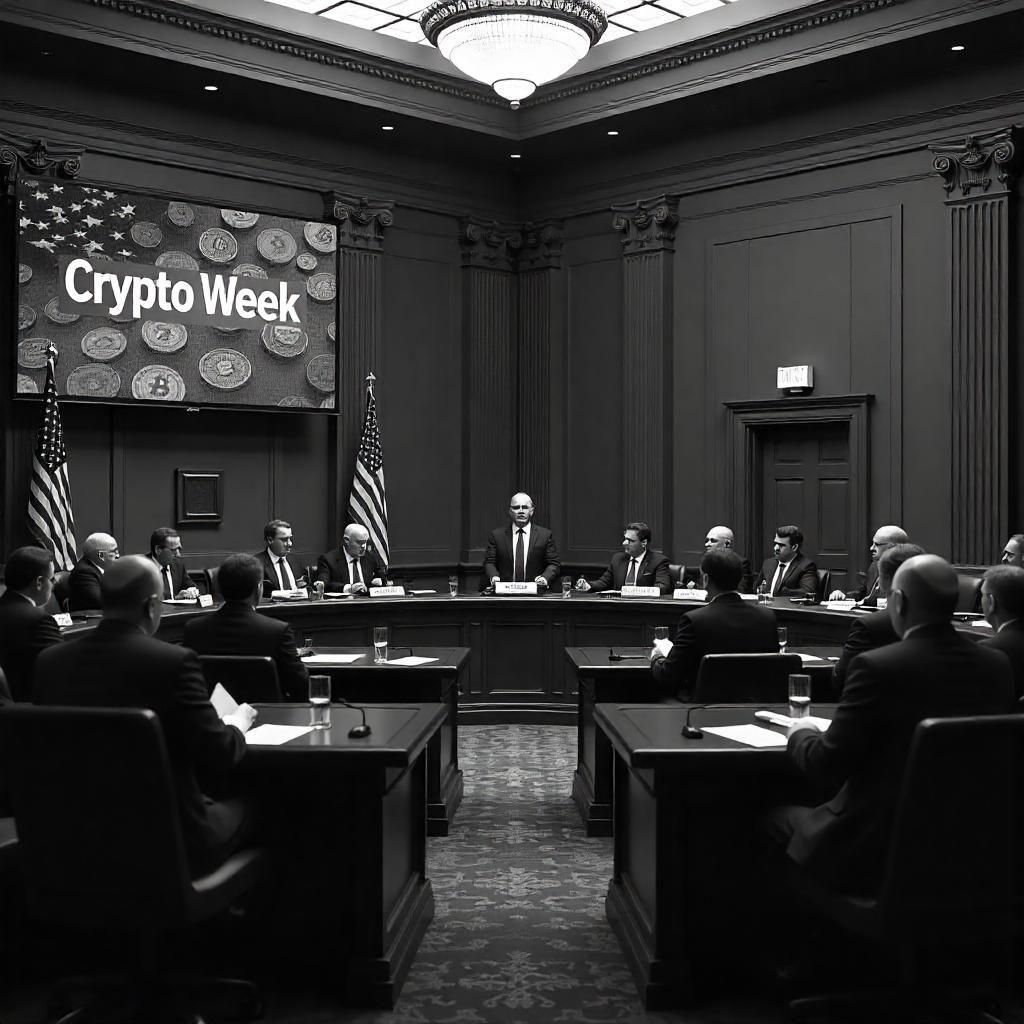America Declares a Digital Asset Agenda
For the first time in U.S. history, Congress is devoting an entire legislative week to digital assets. Dubbed “Crypto Week,” this coordinated effort is more than symbolic—it’s a comprehensive policy push that could reshape how digital finance operates in the United States. Spearheaded by the House Financial Services and Agriculture Committees and backed by the White House, Crypto Week kicks off July 14, 2025, with a full floor vote on three landmark bills: the GENIUS Act (Guiding and Establishing National Innovation for U.S. Stablecoins), the CLARITY Act (Digital Asset Market Structure Clarity Act), and the Anti‑CBDC Surveillance State Act.
President Trump, embracing his growing identity as “the crypto president,” has made digital asset reform a cornerstone of his second term agenda. Following two executive orders earlier this year—one prohibiting a Federal Reserve CBDC and another establishing a strategic Bitcoin reserve—Crypto Week represents the legislative realization of that vision. From Wall Street to Silicon Valley, industry watchers are calling it the most consequential moment for digital assets in U.S. history. The outcome of this week could decide whether the United States becomes the global hub of Web3 innovation or remains mired in regulatory ambiguity.
Key Legislative Pillars
The backbone of Crypto Week is legislation designed to establish firm legal footing for the digital asset ecosystem. Let’s unpack the three pivotal bills that Congress is racing to approve.
The GENIUS Act (Guiding and Establishing National Innovation for U.S. Stablecoins) made history in the Senate on June 17, 2025, passing with a decisive bipartisan vote of 68–30. This marks the first time stablecoin legislation has cleared either congressional chamber. The Act mandates issuers to back every token one-to-one with liquid, low-risk assets—such as U.S. Treasuries—and to uphold rigorous auditing and transparency standards. It introduces a dual federal-state oversight regime, requiring companies to form in the U.S. and to transition under federal supervision if their issuance exceeds $10 billion.
With this federal framework, the GENIUS Act empowers institutional and corporate actors—including giants like Walmart and Amazon—to enter the stablecoin space. Many retailers are already exploring the potential to reduce transaction fees tied to credit card networks. If the House sends it to President Trump’s desk this week, he has signaled strong support, fueled ironically by his personal stake in World Liberty Financial, a stablecoin issuer.
The Digital Asset Market Clarity Act, or CLARITY Act, has gained bipartisan momentum. It recently passed both the House Financial Services and Agriculture committees by votes of 32‑19 and 47‑6 respectively. The CLARITY Act introduces a clear division: digital assets operating on mature, decentralized blockchains fall under the Commodity Futures Trading Commission (CFTC), while the Securities and Exchange Commission (SEC) oversees investment contracts. It offers structured registration for digital commodity exchanges, brokers, and dealers and establishes transparency around token classification, disclosure, and custody rules. By clarifying whether a token is a security or commodity, this legislation seeks to resolve long-standing uncertainty that’s stymied innovation.
Finally, the Anti‑CBDC Surveillance State Act aims to legally block the Federal Reserve from issuing a U.S. central bank digital currency. This law would erect a wall against any digital fiat currency that could be exploited for financial surveillance or social control. Conservative lawmakers argue the move protects individual privacy and limits government overreach into citizens’ personal finance.
Together, these bills form a coherent legislative package: The GENIUS Act provides a structured, enforceable path for stablecoins to thrive in commerce. The CLARITY Act defines the regulatory turf for token oversight. The Anti‑CBDC Act enshrines civil liberties protections. The legislative choreography of Crypto Week—votes on these three bills, followed possibly by a presidential signature—ushers in a new era of crypto policy in the U.S. It reflects a unified push to foster innovation, protect consumers, and position America as a digital-asset leader.
Strategic Context: Why Now?
The timing of Crypto Week is no accident—it reflects months of preparatory momentum both in the executive branch and Capitol Hill. It begins with President Trump’s January 23 Executive Order “Strengthening American Leadership in Digital Financial Technology,” which firmly reversed the previous administration’s cautious stance. That order revoked Biden-era digital asset frameworks, prohibited any development of a U.S. CBDC, and established the President’s Working Group on Digital Asset Markets within 180 days to propose a unified federal regulatory blueprint. By carving out a formal role for major regulators like the SEC and CFTC, this EO laid the groundwork for legislative action.
Just weeks later, in March, Trump’s follow-up executive order established a Strategic Bitcoin Reserve and broader digital-asset stockpile funded entirely through government-forfeited crypto assets. This elevated digital assets to the level of national reserves such as gold or oil and signaled executive endorsement at the highest level. It also triggered active Senate engagement, culminating in a June 17 vote where the GENIUS Act passed by a notable 68–30 margin—an extraordinary show of bipartisan support for stablecoin legislation.
These executive and legislative moves converged into the Senate Banking Committee’s July 9 hearing, which focused on defining a market structure for tokens. Industry figures like Ripple’s CEO Brad Garlinghouse testified on the damaging cost of regulatory uncertainty, advocating for clear rules over fragmented regulation. Senator Elizabeth Warren countered, raising ethical concerns over crypto’s political influence and urging oversight.
The crescendo arrived just before July 14, as market sentiment surged. Bitcoin blew past $118,000, then topped $120,000—on the back of renewed optimism tied directly to these legislative efforts. Analysts point to this rally as evidence that regulatory clarity can unlock both retail enthusiasm and institutional capital.
In summary, Crypto Week stems from a deliberate, multi-phased strategy: a provocative executive edifice, proactive legislative groundwork, bipartisan hearing momentum, and real-time market responses. It reflects a unified push to convert strategic intent into durable policy—making now the moment to act.
Anticipated Impacts on Industry & Consumers
When legislation begins to chart the future of digital finance, the effects ripple far beyond Capitol Hill. For industry players and everyday Americans alike, Crypto Week promises real-world shifts—here’s what’s ahead.
The GENIUS Act’s 1:1 asset backing and audit mandates could unlock stablecoin use in everyday commerce. Retail giants like Walmart and Amazon have expressed interest in issuing their own tokens. Experts suggest that cutting the layers of legacy credit card networks could save billions in transaction fees if stablecoins are both reliable and trusted. The result may be fast, low-cost digital payments even across borders, reshaping how Americans spend and save money.
Market response has been immediate. Bitcoin jumped from about $80,000 in April to break $110,000 before Crypto Week’s launch, recently cresting over $120,000 in a classic “regulatory rally.” Ether, XRP, Solana, and broader crypto equities also climbed, signalling warmed institutional sentiment. A win on legislation could cement positive trends and validate “crypto as digital gold,” even as analysts caution against equating narrative with long-term value.
With legal guardrails in place, institutions may feel safer entering the arena. Corporate treasuries—like MicroStrategy—and major asset managers are increasingly allocating funds to bitcoin and tokenized assets. ETF frameworks are also evolving: new SEC guidance supports crypto-linked funds, paving the way for spot Ether, Solana, or XRP ETFs. Clarity Act provisions could further ease brokerage entry by defining market functions, which boosts confidence from the likes of Coinbase and Bitwise.
If stablecoins go mainstream, individuals may enjoy near-instant settlement, lower fees, cross-border utility, and streamlined payroll systems—even remittances. Tools like wallets with built-in scam protection and regulatory transparency mean safer entry points. But there are caveats: Critics warn of gaps in anti-money laundering protections, potential bank-fiat flight, and uneven consumer safeguards under lighter frameworks.
Collectively, these effects could reorient how Americans save, spend, and invest. With billions potentially shifting out of traditional banking and investment into tokenized ecosystems, Crypto Week could mark a transformative inflection point. Whether these disruptions benefit everyday users depends critically on regulatory balance—supporting innovation while protecting against volatility, fraud, and systemic risk.
Regulatory Certainty: The Core Objective
Regulatory certainty isn’t just a policy buzzword—it’s the foundation upon which digital asset markets can flourish. At the center of Crypto Week, the CLARITY Act offers exactly that clarity by drawing explicit jurisdictional lines between the Securities and Exchange Commission and the Commodity Futures Trading Commission. This separation isn’t theoretical. The bill underwent robust scrutiny in both the House Financial Services and Agriculture Committees, passing hands with votes of 32–19 and 47–6 respectively. It establishes that tokens relying on decentralized blockchain networks will fall under the CFTC’s regulatory scope, while the SEC will retain authority over investment contracts. This explicit delineation eliminates much of the “Howey test” confusion that has previously left token issuers and exchanges uncertain.
But how will this unfold in practice? Token projects will now know with confidence whether they are dealing with securities or commodities. Platforms will have to register appropriately, broker-dealers and custodial services will need to meet clear thresholds, and disclosure rules will be standardized. Crucially, this regulatory roadmap is anchored in the political alignment supporting Crypto Week. House Republicans have framed these three bills—GENIUS, CLARITY, and the anti-CBDC ban—as fulfillment of President Trump’s digital asset agenda. Speaker Mike Johnson, Majority Leader Steve Scalise, and Whip Tom Emmer have underscored that passage demonstrates commitment to American leadership in digital finance.
While industry voices—including Coinbase—have pushed for this clarity, consumer advocates and some Democrats have pushed back. Ranking member Maxine Waters described the week as “dangerous” and likened it to “Anti‑Crypto Corruption Week,” arguing the bills favor industry interests at the expense of consumer protection. That tension underscores why clear regulation is essential—not merely for growth, but to ensure safeguards against fraud, money laundering, and market manipulation.
In essence, regulatory certainty provides both permission and protection. Permission in the form of clear, lawful paths to launch tokens, custody assets, and offer services without fear of sudden enforcement. Protection through defined oversight, required disclosures, and political weight behind consumer safeguards. If enacted, this framework could usher in a new era where U.S.-based innovators can launch without hiding overseas, consumers can trust protocols, and institutional investors can allocate capital without fear of regulatory crackdowns.
Political Landscape & Opposition
While Crypto Week represents an aggressive push for crypto-friendly legislation, it has stirred notable opposition and underscored sharply polarized motivations across the aisle. Republicans, led by Speaker Mike Johnson, Majority Leader Steve Scalise, and Whip Tom Emmer, have framed these bills as central to fulfilling President Trump’s digital asset agenda. Their public messaging emphasizes national leadership, individual freedom, and economic innovation. Chairman French Hill, after announcing “Crypto Week,” stated that this legislative week would cement America’s position as the global leader in crypto, energizing both digital entrepreneurs and everyday users.
Democratic resistance, however, has been vocal and pointed. Representative Maxine Waters condemned the legislative push, labeling it “Anti‑Crypto Corruption Week” and accusing her colleagues of bending to industry interests at the expense of consumer protection. Senator Elizabeth Warren has echoed these concerns at the federal level, warning that the CLARITY Act might tilt the regulatory playing field toward powerful incumbents and potentially sideline robust enforcement against fraud or market manipulation.
Critics also scrutinize the close personal and political ties embedded in this agenda. President Trump’s stake in World Liberty Financial—a stablecoin issuer—and his vocal proclamations as the “crypto president” have fueled accusations that the GENIUS Act caters to his own financial interests. Observers note that major crypto-funded PACs have helped shape congressional makeup, raising questions about the influence of campaign cash on policymaking.
Yet GOP unity remains strong. Chairs Hill, Thompson, and Senate cosponsors Hagerty and Lummis have argued these bills balance innovation with protection—backing stablecoins under strict audit regimes, banning a CBDC to preserve privacy, and establishing market oversight to prevent misuse. Their message is clear: American leadership demands embracing digital assets, not banning them, and safeguarding civil liberties isn’t optional.
For policy watchers, this clash reveals a deeper narrative. It’s not simply about crypto; it’s about trust in government, ideological stances on markets vs. oversight, and setting precedents for future emerging technologies. The outcome of Crypto Week will not only determine crypto’s regulatory landscape but also signal which political forces can define innovation frameworks in the digital age.
What To Expect: Timeline & Next Steps
Crypto Week kicks off with meticulous timing aimed at accelerating high-stakes legislative action. On Monday, July 14, at 4:00 p.m. Eastern, the House Rules Committee will convene to review the three bills integral to Crypto Week: the GENIUS Act, the CLARITY Act, and the Anti‑CBDC Surveillance State Act. This marks the formal launch of the week’s legislative agenda and sets the stage for full-floor debate and votes.
The following day, Tuesday, July 15, is poised to be the busiest. Expect the House floor to begin voting on all three measures, likely in quick succession. Meanwhile, the Senate Agriculture Committee will hold its own hearing on market structure policy—signaling that the CLARITY Act may cross over to the Senate soon.
On Wednesday, July 16, another critical event occurs: the House Ways & Means Committee will host a hearing on crypto taxation at 9:00 a.m. Eastern. This reflects growing legislative focus on fiscal and regulatory dimensions, ensuring tax treatment aligns with emerging digital frameworks.
Assuming smooth passage, the GENIUS Act could be sent to President Trump’s desk by Friday, July 18, potentially becoming the first major crypto bill to be signed into law as part of this concentrated timeline.
Beyond this week, anticipate the CLARITY Act heading to the Senate for its own vote, with Senate leaders like Tim Scott aiming to finalize crypto market structure legislation by the end of September. Post-enactment, rule-making processes and agency designations—SEC and CFTC—will begin implementing frameworks for exchanges, token sales, and custody.
To summarize, Crypto Week’s roadmap is sharply outlined: Monday sees the Rules Committee review launch floor action; Tuesday brings full House votes on all three bills and Senate hearings on structure; Wednesday covers tax policy in Ways & Means; Friday may deliver a presidential signature on the stablecoin law. This timeline reflects a rare moment of legislative alignment—anchored in executive mandates, bipartisan support, and market anticipation. The result could be the most decisive stretch of digital asset policymaking in U.S. history.
Potential Risks & Caveats
Regulatory progress can ignite innovation, but caution is essential. Several real-world risks and pitfalls accompany Crypto Week’s ambitious proposals. First, the GENIUS Act’s stablecoin expansion may unsettle traditional banks. Moody’s warns that if stablecoins divert deposits, banks could lose fee income and lending capacity—though this shift is likely gradual. Europe’s Amundi adds that widespread stablecoin use could threaten sovereign monetary control and prompt capital flight, especially if U.S. Treasuries are used as backing collateral. These structural risks underline that fast-moving change can destabilize established systems.
Second, regulatory gaps persist. Critics liken the GENIUS Act to past financial deregulation like the 2000 Commodity Futures Modernization Act, suggesting it may create oversight loopholes. Democratic voices such as Rep. Maxine Waters warn of an “anti‑crypto corruption week,” expressing fears that these bills favor industry over consumer safety. Senator Elizabeth Warren echoes concern, pointing to unchecked commercial influence in legislation.
Third, the stablecoin model itself carries technical risks. Stablecoins historically have faced run scenarios and de-peg events—TerraUSD’s collapse and Tether’s reserve opacity in 2022 stand out. Even with 1:1 reserve mandates, future sudden redemptions or liquidity mismatches could expose vulnerabilities not yet addressed in legislative drafts. The BIS and Bank of England caution that private stablecoins may lack guarantees comparable to bank deposits.
Finally, the broader economic impact remains uncertain. Bitcoin’s rally to over $120,000 signals optimism but traders like Simon Peters at eToro caution a pullback is possible, especially if legislative momentum stalls. Moreover, integrating crypto into mortgages or lending without mature frameworks could expose consumers—some experts urge adding safeties like haircuts or limits before widespread use in credit markets.
Taken together, Crypto Week’s proposals are a high-wire act. They offer the promise of U.S. crypto leadership, but they also expose the nation to systemic, consumer-protection, and macroeconomic dangers. Keystone to success will be careful rule-making, vigilant oversight, and adaptability to unforeseen challenges.
Crypto Week May Be Just the Beginning
As the dust settles on Crypto Week, several truths are clear. This legislative sprint is historic in ambition and scope. With the GENIUS, CLARITY, and Anti‑CBDC acts, Congress and the White House are sending a unified message: digital assets are central to America’s economic future. The bills offer a coherent blueprint for stablecoin integration, market structure clarity, and civil-liberty protections.
But the road ahead matters more than the week itself. Successful implementation depends on the depth and speed of regulatory follow-through. Agencies must translate broad congressional mandates into detailed rules that balance innovation, stability, and consumer safeguards. If they succeed, U.S. industry can confidently build domestically, attracting institutional capital and everyday users.
Yet the political and economic stakes remain high. Opposition voices warn of corporate favoritism, inadequate protections, and unforeseen systemic risks. Every claim of crypto freedom must be weighed against warnings from economists and central bankers.
In the end, Crypto Week may be remembered as the signal event of a new digital finance era—or as a cautionary tale of legislative overreach. For policymakers, industry leaders, and citizens, the imperative is the same: stay informed, engage critically, and demand transparency at every stage. The future of America’s financial system is in motion—and Crypto Week may be just the beginning of what’s possible.





